Although this tree is not Asian, since it is often planted in Laos, we will say a few words about it to inform our readers.
You will have guessed that African Tulip Tree comes from Africa where it is sometimes called “fountain tree” or “piss-piss” because the flower buds swell by retaining rainwater which then escapes when the flowers open. The Lao and the Thais have found a resemblance between its flower and that of a Bignone which they are fond of, dok khè. It is also this tulip-shaped flower that gives the English and French names. The first description of this tulip tree dates from 1787, we owe it to Ambroise de Beauvois who created the name Spathodea because the flower looks like a spathe or spatula. It was introduced into botanical collections in Europe in 1858 and from there planted in all tropical countries as a decorative plant. It is indeed a beautiful tree of about fifteen meters high, with a rounded crown, a straight trunk, with dark green, compound leaves. The downy flower buds appear at the end of the branches and bloom successively around the edge of the inflorescence. The large flowers are orange-red, campanulate, open at the top; there is a rarer species with brilliant yellow flowers. Flowering, which takes place all year round, is followed by elongated and erect, boat-shaped pods which open to release winged seeds.
African Tulip Tree reproduces very easily, it adapts to any type of soil as long as there is plenty of sunshine.
Its fragile wood is soft and brittle and the marabouts of West Africa use it to carve talismans, it is also called for this reason “sorcerer’s staff”. In Singapore they make paper out of it. In many regions it is said that the seeds of the Tulip tree are edible, but in Africa it is also said that they are used to make arrow poison!
In Africa and India this tree is an important medicinal plant. The stem bark is used to treat skin problems and diarrhea. The leaves are said to be effective in kidney diseases and urinary tract infections; they would also be an antidote against certain poisons. The pharmaceutical industry has therefore analyzed this plant, found a large number of interesting molecules, and demonstrated in vitro antimalarial activity.
The paradox of the Tulip tree of Gabon is that in its continent of origin where it is over-exploited for its various uses it is registered on the list of plants to be protected and the governments encourage its reproduction. On the contrary in many countries where it has been introduced, especially the Pacific, it is considered invasive; it invades cultivated areas, plantation forests as well as natural ecosystems. In addition, this beautiful tree has been planted a lot in urban areas, but its powerful root system harms urban surfaces and is dangerous for pipes.
Bien que cet arbre ne soit pas asiatique, puisqu’il est souvent planté au Laos, nous en dirons quelques mots pour renseigner nos lecteurs.
Vous aurez devinez que le Tulipier du Gabon vient d’Afrique où on l’appelle parfois « arbre fontaine » ou « pisse-pisse » parce que les boutons floraux se gonflent en retenant l’eau de pluie qui s’échappe ensuite quand les fleurs s’ouvrent. Les Lao et les Thaï ont trouvé une ressemblance entre sa fleur et celle d’une Bignone dont ils sont friands, dok khè. C’est aussi cette fleur en forme de tulipe qui donne les noms anglais et français. La première description de ce Tulipier date de 1787, on la doit à Ambroise de Beauvois qui crée le nom de Spathodea car la fleur ressemble à une spathe ou spatule. Il a été introduit dans les collections botaniques en Europe en 1858 et de là planté dans tous les pays tropicaux comme plante décorative. C’est en effet un bel arbre d’une quinzaine de mètres de haut, à cime arrondie, à fût droit, à feuilles vert foncé, composées. Les boutons floraux duveteux apparaissent à l’extrémité des rameaux et s’épanouissent successivement sur le pourtour de l’inflorescence. Les grandes fleurs sont rouge orangé, campanulées, ouvertes vers le haut; il en existe une espèce plus rare aux fleurs d’un jaune brillant. La floraison qui a lieu toute l’année, est suivie par des gousses allongées et dressées, en forme de bateau, qui s’ouvrent pour laisser s’envoler des graines ailées.
Le tulipier du Gabon se reproduit très facilement, il s’adapte à tout type de sol pourvu que l’ensoleillement soit important.
Son bois fragile est mou et cassant et les marabouts d’Afrique de l’Ouest l’utilisent pour sculpter des talismans on l’appelle aussi pour cette raison « bâton de sorcier ». A Singapour on en fait du papier. Dans plusieurs régions on dit que les graines du Tulipier sont comestibles, mais on dit aussi en Afrique qu’elles servent à faire du poison de flèche !
En Afrique et en Inde cet arbre est une plante médicinale importante. L’écorce des tiges est utilisée pour soigner les problèmes de peau et les diarrhées. Les feuilles seraient efficaces dans les maladies de rein et les infections urinaires; elles seraient en outre un antidote contre certains poisons. L’industrie pharmaceutique a donc analysé cette plante, a trouvé un grand nombres de molécules intéressantes, et a démontré in vitro une activité antipaludéenne.
Le paradoxe du Tulipier du Gabon c’est que dans son continent d’origine où il est surexploité pour ses différents usages il est inscrit sur la liste des plantes à protéger et les gouvernements en encouragent la reproduction. Au contraire dans de nombreux pays où il a été introduit, en particulier le Pacifique, il est considéré comme un invasif; il envahit les zones cultivées, les forêts de plantation aussi bien que les écosystèmes naturels. En outre, ce bel arbre a été beaucoup planté en zone urbaine mais son système racinaire puissant nuit aux revêtements urbains et est dangereux pour les canalisations.
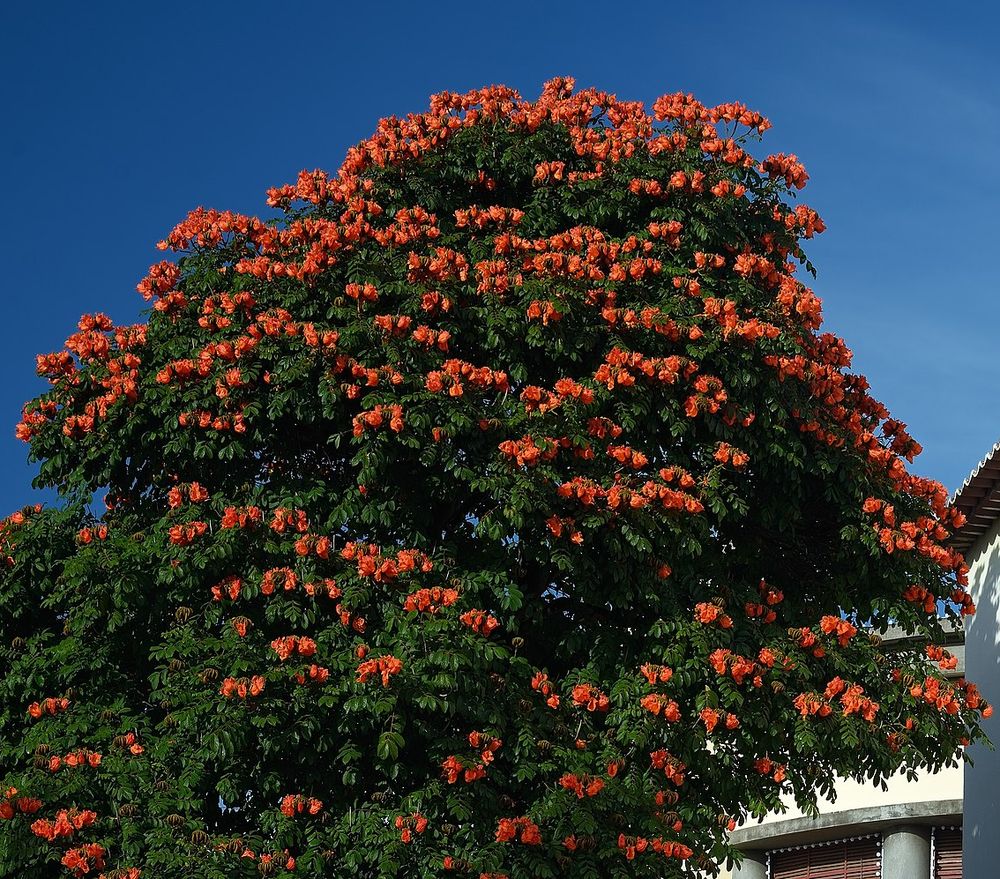
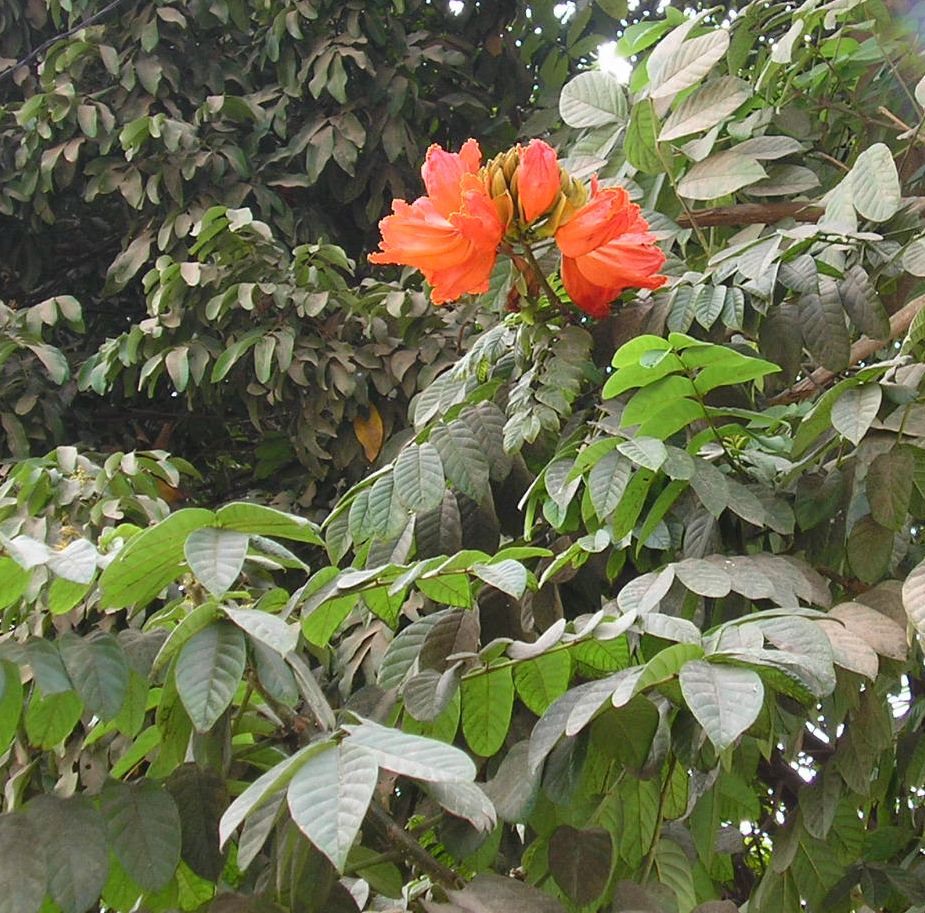
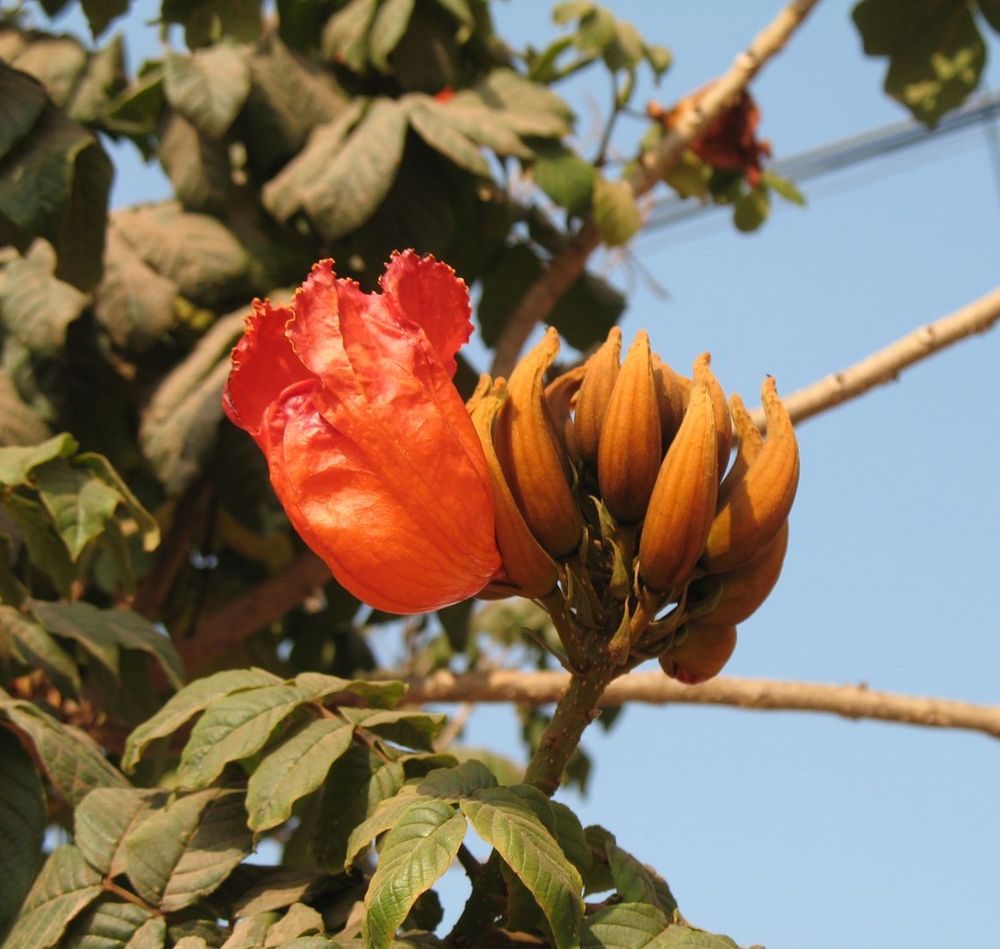
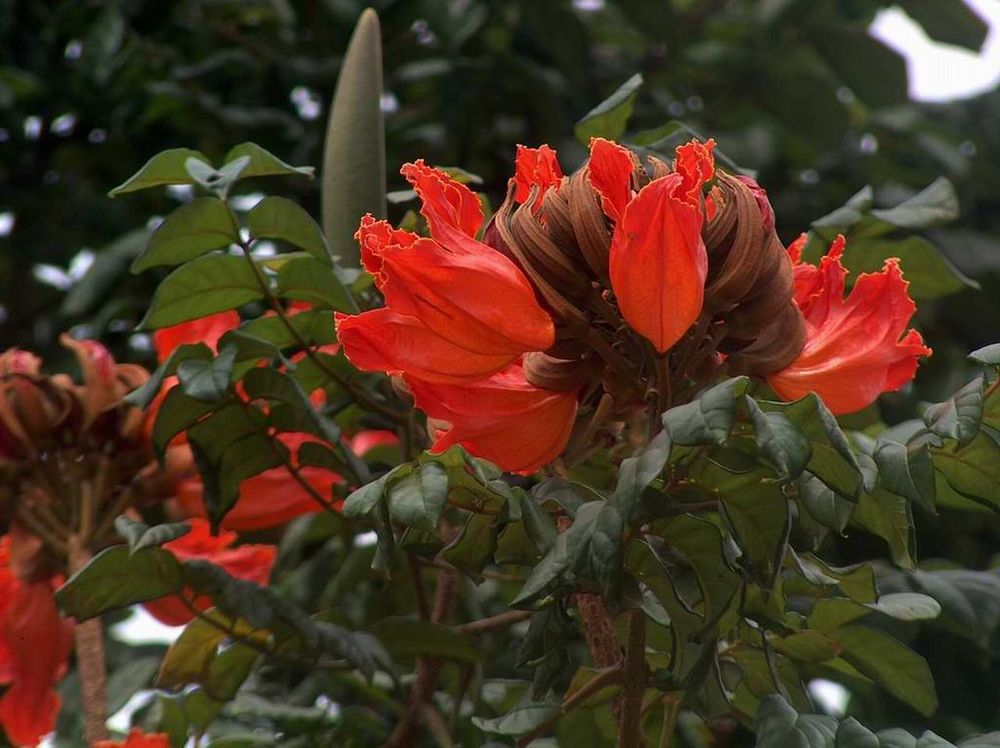
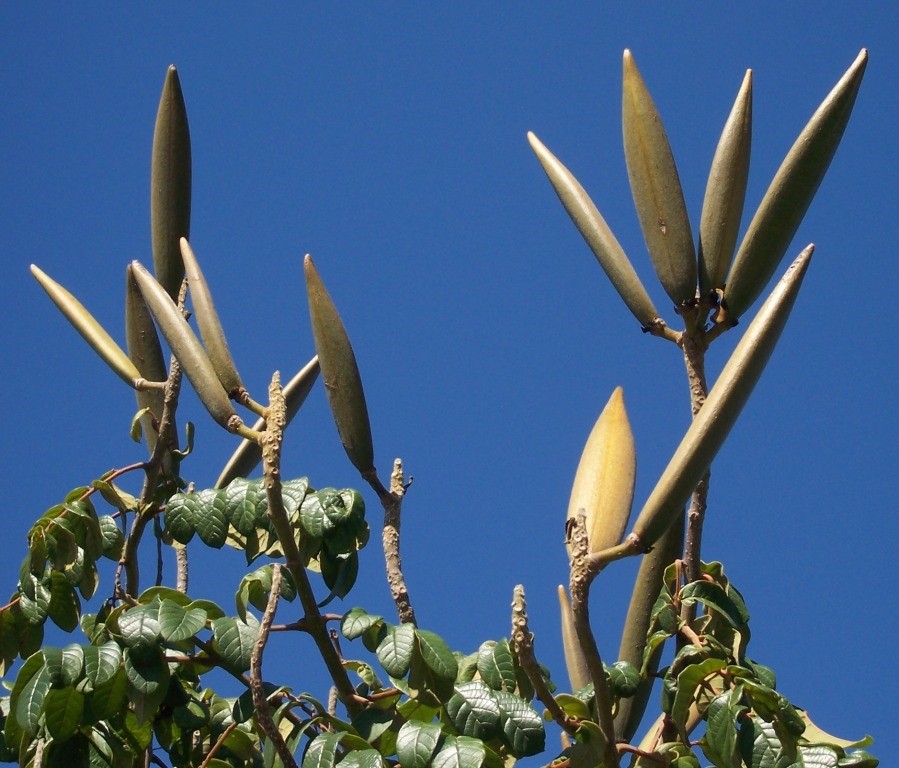
Although this tree is not Asian, since it is often planted in Laos, we will say a few words about it to inform our readers.
You will have guessed that African Tulip Tree comes from Africa where it is sometimes called “fountain tree” or “piss-piss” because the flower buds swell by retaining rainwater which then escapes when the flowers open. The Lao and the Thais have found a resemblance between its flower and that of a Bignone which they are fond of, dok khè. It is also this tulip-shaped flower that gives the English and French names. The first description of this tulip tree dates from 1787, we owe it to Ambroise de Beauvois who created the name Spathodea because the flower looks like a spathe or spatula. It was introduced into botanical collections in Europe in 1858 and from there planted in all tropical countries as a decorative plant. It is indeed a beautiful tree of about fifteen meters high, with a rounded crown, a straight trunk, with dark green, compound leaves. The downy flower buds appear at the end of the branches and bloom successively around the edge of the inflorescence. The large flowers are orange-red, campanulate, open at the top; there is a rarer species with brilliant yellow flowers. Flowering, which takes place all year round, is followed by elongated and erect, boat-shaped pods which open to release winged seeds.
African Tulip Tree reproduces very easily, it adapts to any type of soil as long as there is plenty of sunshine.
Its fragile wood is soft and brittle and the marabouts of West Africa use it to carve talismans, it is also called for this reason “sorcerer’s staff”. In Singapore they make paper out of it. In many regions it is said that the seeds of the Tulip tree are edible, but in Africa it is also said that they are used to make arrow poison!
In Africa and India this tree is an important medicinal plant. The stem bark is used to treat skin problems and diarrhea. The leaves are said to be effective in kidney diseases and urinary tract infections; they would also be an antidote against certain poisons. The pharmaceutical industry has therefore analyzed this plant, found a large number of interesting molecules, and demonstrated in vitro antimalarial activity.
The paradox of the Tulip tree of Gabon is that in its continent of origin where it is over-exploited for its various uses it is registered on the list of plants to be protected and the governments encourage its reproduction. On the contrary in many countries where it has been introduced, especially the Pacific, it is considered invasive; it invades cultivated areas, plantation forests as well as natural ecosystems. In addition, this beautiful tree has been planted a lot in urban areas, but its powerful root system harms urban surfaces and is dangerous for pipes.
Bien que cet arbre ne soit pas asiatique, puisqu’il est souvent planté au Laos, nous en dirons quelques mots pour renseigner nos lecteurs.
Vous aurez devinez que le Tulipier du Gabon vient d’Afrique où on l’appelle parfois « arbre fontaine » ou « pisse-pisse » parce que les boutons floraux se gonflent en retenant l’eau de pluie qui s’échappe ensuite quand les fleurs s’ouvrent. Les Lao et les Thaï ont trouvé une ressemblance entre sa fleur et celle d’une Bignone dont ils sont friands, dok khè. C’est aussi cette fleur en forme de tulipe qui donne les noms anglais et français. La première description de ce Tulipier date de 1787, on la doit à Ambroise de Beauvois qui crée le nom de Spathodea car la fleur ressemble à une spathe ou spatule. Il a été introduit dans les collections botaniques en Europe en 1858 et de là planté dans tous les pays tropicaux comme plante décorative. C’est en effet un bel arbre d’une quinzaine de mètres de haut, à cime arrondie, à fût droit, à feuilles vert foncé, composées. Les boutons floraux duveteux apparaissent à l’extrémité des rameaux et s’épanouissent successivement sur le pourtour de l’inflorescence. Les grandes fleurs sont rouge orangé, campanulées, ouvertes vers le haut; il en existe une espèce plus rare aux fleurs d’un jaune brillant. La floraison qui a lieu toute l’année, est suivie par des gousses allongées et dressées, en forme de bateau, qui s’ouvrent pour laisser s’envoler des graines ailées.
Le tulipier du Gabon se reproduit très facilement, il s’adapte à tout type de sol pourvu que l’ensoleillement soit important.
Son bois fragile est mou et cassant et les marabouts d’Afrique de l’Ouest l’utilisent pour sculpter des talismans on l’appelle aussi pour cette raison « bâton de sorcier ». A Singapour on en fait du papier. Dans plusieurs régions on dit que les graines du Tulipier sont comestibles, mais on dit aussi en Afrique qu’elles servent à faire du poison de flèche !
En Afrique et en Inde cet arbre est une plante médicinale importante. L’écorce des tiges est utilisée pour soigner les problèmes de peau et les diarrhées. Les feuilles seraient efficaces dans les maladies de rein et les infections urinaires; elles seraient en outre un antidote contre certains poisons. L’industrie pharmaceutique a donc analysé cette plante, a trouvé un grand nombres de molécules intéressantes, et a démontré in vitro une activité antipaludéenne.
Le paradoxe du Tulipier du Gabon c’est que dans son continent d’origine où il est surexploité pour ses différents usages il est inscrit sur la liste des plantes à protéger et les gouvernements en encouragent la reproduction. Au contraire dans de nombreux pays où il a été introduit, en particulier le Pacifique, il est considéré comme un invasif; il envahit les zones cultivées, les forêts de plantation aussi bien que les écosystèmes naturels. En outre, ce bel arbre a été beaucoup planté en zone urbaine mais son système racinaire puissant nuit aux revêtements urbains et est dangereux pour les canalisations.










Although this tree is not Asian, since it is often planted in Laos, we will say a few words about it to inform our readers.
You will have guessed that African Tulip Tree comes from Africa where it is sometimes called “fountain tree” or “piss-piss” because the flower buds swell by retaining rainwater which then escapes when the flowers open. The Lao and the Thais have found a resemblance between its flower and that of a Bignone which they are fond of, dok khè. It is also this tulip-shaped flower that gives the English and French names. The first description of this tulip tree dates from 1787, we owe it to Ambroise de Beauvois who created the name Spathodea because the flower looks like a spathe or spatula. It was introduced into botanical collections in Europe in 1858 and from there planted in all tropical countries as a decorative plant. It is indeed a beautiful tree of about fifteen meters high, with a rounded crown, a straight trunk, with dark green, compound leaves. The downy flower buds appear at the end of the branches and bloom successively around the edge of the inflorescence. The large flowers are orange-red, campanulate, open at the top; there is a rarer species with brilliant yellow flowers. Flowering, which takes place all year round, is followed by elongated and erect, boat-shaped pods which open to release winged seeds.
African Tulip Tree reproduces very easily, it adapts to any type of soil as long as there is plenty of sunshine.
Its fragile wood is soft and brittle and the marabouts of West Africa use it to carve talismans, it is also called for this reason “sorcerer’s staff”. In Singapore they make paper out of it. In many regions it is said that the seeds of the Tulip tree are edible, but in Africa it is also said that they are used to make arrow poison!
In Africa and India this tree is an important medicinal plant. The stem bark is used to treat skin problems and diarrhea. The leaves are said to be effective in kidney diseases and urinary tract infections; they would also be an antidote against certain poisons. The pharmaceutical industry has therefore analyzed this plant, found a large number of interesting molecules, and demonstrated in vitro antimalarial activity.
The paradox of the Tulip tree of Gabon is that in its continent of origin where it is over-exploited for its various uses it is registered on the list of plants to be protected and the governments encourage its reproduction. On the contrary in many countries where it has been introduced, especially the Pacific, it is considered invasive; it invades cultivated areas, plantation forests as well as natural ecosystems. In addition, this beautiful tree has been planted a lot in urban areas, but its powerful root system harms urban surfaces and is dangerous for pipes.
Bien que cet arbre ne soit pas asiatique, puisqu’il est souvent planté au Laos, nous en dirons quelques mots pour renseigner nos lecteurs.
Vous aurez devinez que le Tulipier du Gabon vient d’Afrique où on l’appelle parfois « arbre fontaine » ou « pisse-pisse » parce que les boutons floraux se gonflent en retenant l’eau de pluie qui s’échappe ensuite quand les fleurs s’ouvrent. Les Lao et les Thaï ont trouvé une ressemblance entre sa fleur et celle d’une Bignone dont ils sont friands, dok khè. C’est aussi cette fleur en forme de tulipe qui donne les noms anglais et français. La première description de ce Tulipier date de 1787, on la doit à Ambroise de Beauvois qui crée le nom de Spathodea car la fleur ressemble à une spathe ou spatule. Il a été introduit dans les collections botaniques en Europe en 1858 et de là planté dans tous les pays tropicaux comme plante décorative. C’est en effet un bel arbre d’une quinzaine de mètres de haut, à cime arrondie, à fût droit, à feuilles vert foncé, composées. Les boutons floraux duveteux apparaissent à l’extrémité des rameaux et s’épanouissent successivement sur le pourtour de l’inflorescence. Les grandes fleurs sont rouge orangé, campanulées, ouvertes vers le haut; il en existe une espèce plus rare aux fleurs d’un jaune brillant. La floraison qui a lieu toute l’année, est suivie par des gousses allongées et dressées, en forme de bateau, qui s’ouvrent pour laisser s’envoler des graines ailées.
Le tulipier du Gabon se reproduit très facilement, il s’adapte à tout type de sol pourvu que l’ensoleillement soit important.
Son bois fragile est mou et cassant et les marabouts d’Afrique de l’Ouest l’utilisent pour sculpter des talismans on l’appelle aussi pour cette raison « bâton de sorcier ». A Singapour on en fait du papier. Dans plusieurs régions on dit que les graines du Tulipier sont comestibles, mais on dit aussi en Afrique qu’elles servent à faire du poison de flèche !
En Afrique et en Inde cet arbre est une plante médicinale importante. L’écorce des tiges est utilisée pour soigner les problèmes de peau et les diarrhées. Les feuilles seraient efficaces dans les maladies de rein et les infections urinaires; elles seraient en outre un antidote contre certains poisons. L’industrie pharmaceutique a donc analysé cette plante, a trouvé un grand nombres de molécules intéressantes, et a démontré in vitro une activité antipaludéenne.
Le paradoxe du Tulipier du Gabon c’est que dans son continent d’origine où il est surexploité pour ses différents usages il est inscrit sur la liste des plantes à protéger et les gouvernements en encouragent la reproduction. Au contraire dans de nombreux pays où il a été introduit, en particulier le Pacifique, il est considéré comme un invasif; il envahit les zones cultivées, les forêts de plantation aussi bien que les écosystèmes naturels. En outre, ce bel arbre a été beaucoup planté en zone urbaine mais son système racinaire puissant nuit aux revêtements urbains et est dangereux pour les canalisations.


